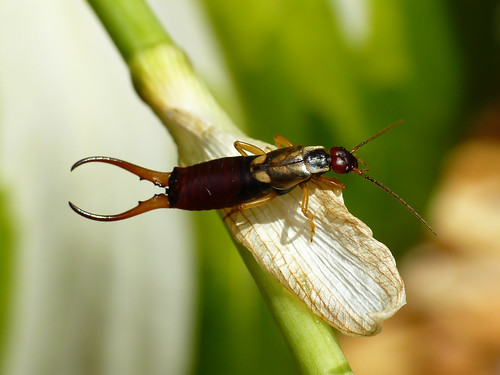Controlling Earwig Problems
Earwigs do not deserve their bad reputation in the garden or inside your ear for that matter.
Problems Earwigs Cause
- Earwigs are night feeders and chew holes in foliage and vegetables.
- Flowers and blossom can also become food for a hungry Earwig as can very small insects.
- Earwig families look threatening but do not eat as copiously as some insects.
- Dahlias can become infested with earwigs and they drop out of the flowers when brought inside.
Controlling Earwigs
- Handpick your earwig off your plant with tweezers and unless you are squirmish squish them.
- Submerge an infested plant in water and the earwigs will leave the plant. They hate water.
- If these measures are impractical use a systemic insecticed
- Put an inverted plant pot filled with straw over the canes supporting dahlias and the earwigs will gather there to be destroyed.
- Place a sticky barrier at the base of woody plants. Earwigs are crawlers and they should get stuck.
More on Earwigs
- Earwig species latin names include Forficula auricularia and Euborellia annulipes.
- Earwig s are brown or black and have sharp pincers at the tail end. They use these pincers to capture insect prey and for mating and the mouth end for nibbling your plants.
- Damp places are home to earwigs, under pots or in loose mulch. Keep a clean regime and cut down earwig breeding options.
- Females lay eggs in spring and watch over them until they hatch and moult.
- Earwigs undergo five moults in a year, their average life expectancy.
| The top photo is licensed under the Creative Commons Attribution-Share Alike 3.0 Unported license. | |
| Attribution: James Lindsey at Ecology of Commanster |
Bottom photo and commentary below from Sankaz on flickr under creative commons
Commentary
‘Earwigs are members of the Order Dermaptera, a group of insects that are distant relatives of the Orthoptera (roaches, crickets, grasshoppers and katydids). The most noticeable physical characteristic of earwigs is the presence of two pincer-like appendages that emerge from the tip of the abdomen called cerci.
Males usually have longer, curved cerci than females’ shorter straight forceps. Some species can inflict a painful pinch with their cerci, but most species are harmless if handled. This one gave me a little pinch. The cerci are used for defense and for capturing prey. Contrary to the old wives’ tale, they do not crawl into your ears at night.
These insects do not bite humans. They are mainly scavengers, feeding on organic material, garbage, and dead insects. Some herbivorous species can damage young crop plants and ornamentals, especially when the earwigs occur in large numbers. Some species are predatory on other insects, especially larvae.
Note that earwigs are somewhat flattened and very flexible. This enables them to hide in all sorts of nooks and crannies by day, and come out at night to feed. Their nocturnal habits explain why many people never see them until they turn over a board, a piece of siding, or almost anywhere that might provide a good hiding place. The adults have a pair of wings beneath the leathery wing covers and are capable of flying.
Raynox DCR-250 mounted on my Panasonic FZ8.’


2 thoughts on “Controlling Earwig Problems”
I hope I win a prize for finding grammatical errors in your text. Surely you planted them there. Or maybe you could use a copy editor. 😉
Comments are closed.